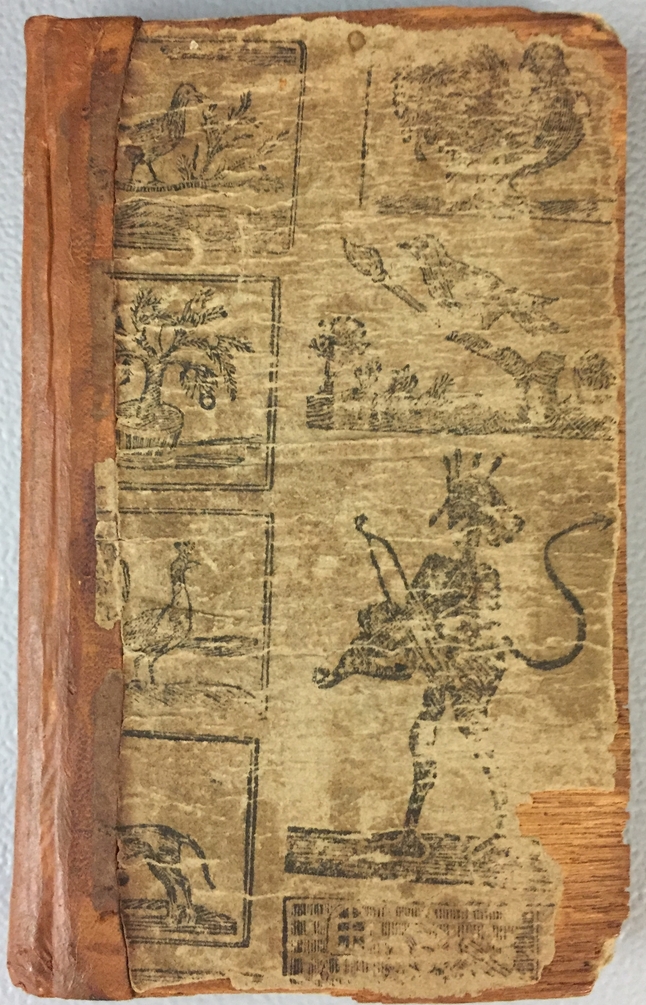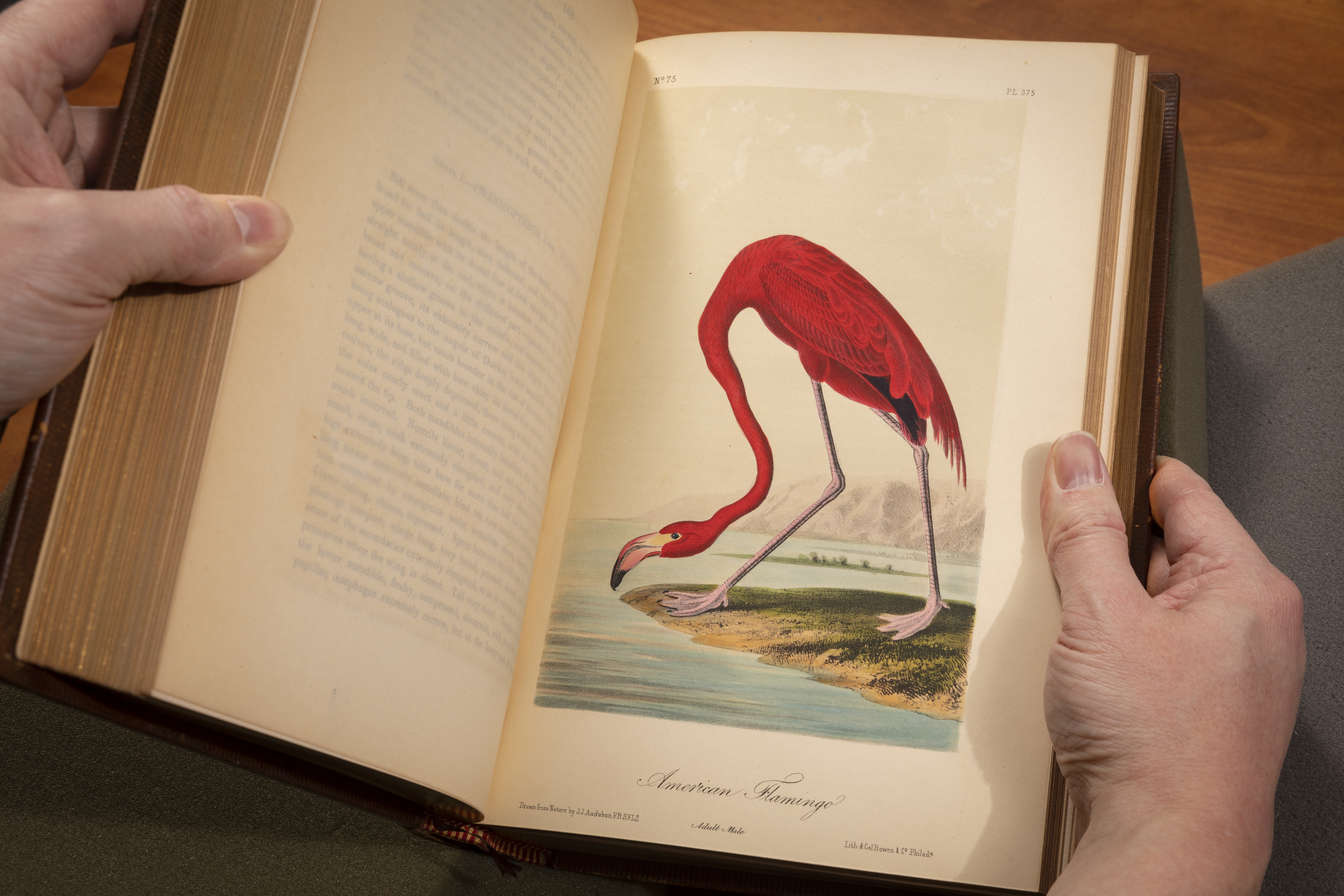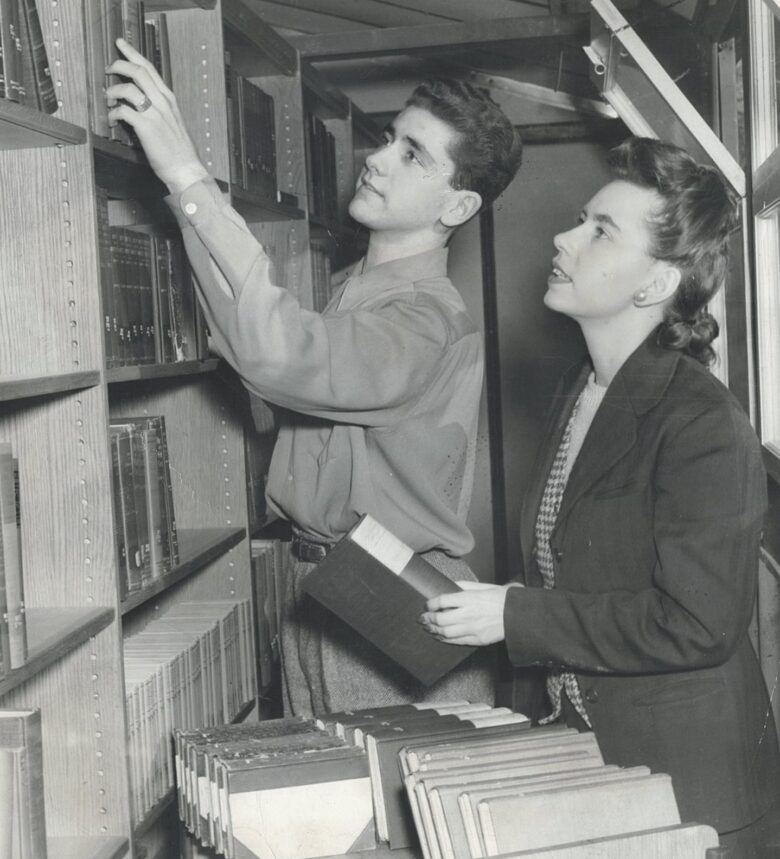Subject Guides
Binghamton University Libraries' Exhibits: Special Collections
Guide Contents
Current Exhibit

Service and Solidarity: Historically Black Fraternities and Sororities at Binghamton
In this exhibit we highlight feminist activism in our collections. The materials on display offer glimpses into local, national, and international feminist activism, though the exhibit’s strength lies in how well it documents Second Wave Feminism. A major driving force behind many of the legal and social gains women made in the 1960s through 1980s, Second Wave Feminism was concerned with issues like abortion, domestic violence, divorce, workplace discrimination and much more. The movement also gave rise to many well known institutions serving women today such as Women’s Studies programs, women’s centers, rape crisis centers, and more. While this exhibit does not comprehensively document any one issue or organization, it does give a broad sense of how feminists organized, what the core concerns were, and how activists kept in contact with each other.
This is the second Special Collections exhibit in a series on activism. The first was on peace action and disarmament. These exhibits are designed to highlight that Special Collections is not just home of the ‘official’ historical record, which often exists in government documents, mainstream newspapers, and popular histories. Rather, our collections also contain counter-cultural materials which document people challenging the status quo.
Visit Special Collections anytime 10 a.m. – 4 p.m. Monday through Friday. No appointment is required to view the exhibit.
Special Collections: Past Exhibits

Service and Solidarity: Historically Black Fraternities and Sororities at Binghamton
This exhibit features the history of Binghamton University chapters of Black Greek-Letter Organizations (BGLOs), “Black Greeks,” or more inclusively, traditionally Black fraternal organizations. The exhibit traces the history of nine campus chapters, the first of which were established in the early 1980s, and speaks to the function of BGLOS at Binghamton as a predominantly white institution. In addition to materials from Special Collections, visitors will see objects on loan from students, alumni and staff who are proud to share their enthusiasm as members of these organizations.
The exhibit is on view outside Special Collections during Bartle North Reading Room hours. Also on view, in the Bartle Library Mezzanine, is a companion exhibit about the history of national Black fraternal organizations and the resources which Binghamton University Libraries make available on this topic.

All That’s Fit for Student Print: Binghamton University Student Publications, 1946 - Present
Students have been reporting news, sharing creative writing and art, composing in-depth articles on culture and politics, and editorializing on all manner of subjects since 1946 with the first publication of the student newspaper Colonial News. As Triple Cities College became Harpur College and eventually Binghamton University, the number and variety of publications created by students expanded. Today, Special Collections holds more than 100 titles of varying genres, styles, and points of view.
This exhibit illustrates the range of student voices and genres represented in the Binghamton University Publications collection.
This exhibit was on display through August 2024.

Curtain Call: Selections from the Theatre History Collection
This exhibit features selections from the diverse materials in the Theatre History Collection held in Special Collections originally gathered by Theatre Department faculty beginning in the 1960s. This extensive collections contains broadsides, more than 450 scrapbooks, programs and playbills, costume drawings, photographs and more. The main focus of the collection is theater but there are also materials relating to motion pictures, music and dance.
This exhibit is on display through the Fall of 2023.

Farming Empire: Agriculture and Related Industries in Upstate New York
This exhibit draws on manuscripts, rare books, and printed ephemera held in Special Collections to showcase the long history of farming and agriculture-adjacent industries in the upstate region. From apples and dairy to hops and poultry, agricultural products have been a key component of the local economy for generations: the materials featured in this exhibit highlight some of the many ways in which upstate farmers shared information, advertised and promoted their products, and dealt with hardships such as pests and the rigors of wartime.
This exhibit is on display through December 2022

Recent Acquisitions (Spring 2022)
Our Spring 2022 exhibit features new acquisitions to Special Collections, including a 1696 book of food and medical recipes, a collection of ten Buddhist amulet scrolls, several nineteenth-century storybooks and ABCs for children; and the first book printed with moveable music type in America, an edition of the Psalms published in New York in 1767. Local history materials in the exhibit include an early geography textbook of Chenango County; a chapbook edition of The Popular Story of Blue Beard published in Cooperstown, Otsego County; and several photographs of candy salesmen based at a firm in Binghamton around 1902.
This exhibit was on display through May 2022

Recent Acquisitions (Fall 2021)
Our first fall 2021 exhibit features new acquisitions to Special Collections, including a broadside for an anti-Jackson party convention held in Tioga County (1832); a woodblock used for printing two leaves of a Japanese novel (circa 1830); a Gus-Hall Jarvis Tyner election poster (1976); and an Indonesian divination book written on alim-tree bark (mid-20th century). Local history materials on display include an album containing more than 150 early-twentieth century photographs taken in the Port Crane area; diary volumes written by two local women in 1868 and 1917; two letters written by a young Owego newspaper editor in the 1850s; and several postcards and pieces of ephemera.
This exhibit was on display from August 27 through October 31, 2021.

(Re)presenting the Birds of America
Highlighting the recent acquisition of an 1859 third octavo edition of Audubon’s Birds of America, this exhibit featured volumes from the Audubon set, as well as other ornithological materials from Special Collections. Material on display included additional Audubon facsimiles, earlier illustrations of American birds from eighteenth-century periodicals, and an illustrated edition of Susan Fenimore Cooper’s Rural Hours.
This exhibit was on display from November 9 through December 17, 2021.

Diamond in the Rough: A Look Back at the University’s Inaugural Year, 1946-1947
To celebrate the 75th anniversary of the founding of Triple Cities College, this exhibit features newspaper articles, the first yearbook and course bulletin, as well as photographs and memorabilia from the 1946-1947 academic year. Triple Cities College was founded as a satellite school of Syracuse University, to meet the increasing educational needs of local veterans. It was the first liberal arts college established in this area. Triple Cities College was renamed Harpur College in 1950 when it became part of the State University of New York system.
This exhibit was on display from September 30, 2021 through May 2022.

What's So Funny in Special Collections? Humor Comes in Many Forms.
Dr. Seuss once said "From there to here, and here to there, funny things are everywhere" and this includes Special Collections. Humor can take many different styles and be included in a wide range of media from comic strips to film. This exhibit features representations of humor including political cartoons, comics, animation and film. From 18th century political cartoons to Shrek, the materials displayed are sure to make you smile.
The exhibit was on display from October 21, 2019 through March 13, 2020.

Leaves of Grass: Walt Whitman's Masterwork
Libraries and poetry lovers around the world are commemorating the 200th birthday of the great American poet, Walt Whitman, born on May 31, 1819, in West Hills, NY on Long Island. Writing and revising his collection of poems, Leaves of Grass, which was first published in 1855 and is composed in free verse around themes of identity, love, sexuality, democracy, loss, and death, was his lifelong work. Whitman and his ever-evolving Leaves of Grass generated praise, critique, and discussion from the moment it made its first appearance to the present day. In the upcoming months, Special Collections will display some of its holdings related to Leaves of Grass. Like the work itself, the exhibit will change during the course of its installation — volumes were added and removed, pages were turned and unfolded, and our original first edition was on display on selected days.
The exhibit was on display from May 31 through September 30, 2019.

Glenn G. Bartle: His Life and Legacy
Glenn G. Bartle, for whom the library building at Binghamton University was renamed 40 years ago, was a geologist, professor and college administrator. In the 1950s, he became president of Harpur College, which then became SUNY at Binghamton in 1965. Bartle was instrumental in the development of what has become a preeminent public university. An exhibit on view until February 1, 2019 in Special Collections examines his early training and career as a geologist, his expanding roles in higher education, and the transformative years during which he led the campus and academic programs at the university into new realms. An auxiliary exhibit outside of Special Collections surveys the development of what is now the Glenn G. Bartle Library.
The exhibit was on display until February 1, 2019.

Here, There and Everywhere: Traveling Through Special Collections presents a wide variety of travel-related materials from several collections spanning four decades, from travel guides, pamphlets and postcards to passports, travel documents and more. Envision yourself on the Grand Tour of Europe in the 1700s, peruse a 19th century guidebook to a local lake, discover the difficulties of traveling during and after WWII, and see what was happening on the Brooklyn jazz scene in 2001. This exhibition illustrates what travel was like in the Southern Tier, around the U.S., and across the world from the 18th century to today. Take a tour of the different materials that Special Collections has to offer!

Abracadabra: Magic in Special Collections highlights materials relating to magic, sorcery and trickery from around the world. Prepare to be amazed as you view materials held in the Libraries' Special Collections, from an early 20th century advertising board for Kaylo the Magician to Maurice Perchron's Magie, rites et mystéres d'Asie to radio scripts for Chandu the Magician.
Abracadabra: Magic in Special Collections exhibit is located in the Libraries' Special Collections and University Archives Department in Bartle Library.

Vote for Woman Suffrage! Commemorating 100 Years of Women’s Suffrage in New York State, 1917-2017 exhibit explored the suffrage movement from the Seneca Falls Convention to the fight by suffrage organizations in the Triple Cities for the woman’s right to vote. Items from the re-enactment of the 1913 Binghamton suffrage parade and the 2017 Women’s March was on display as well. The exhibit was on view from November 15, 2017-January 31, 2018..

This exhibit highlighted the Libraries’ collection of facsimiles of some of the most beautifully illustrated codices, scrolls and printed works from Europe and Asia. Many of these works, such as the Gutenberg Bible or the Book of Kells, are unattainable for most libraries, but facsimiles allow scholars to conduct their research, professors to teach and students to study such exquisite and unique works without having to travel long distances at a great cost of time and expensive. Read more about the Ellesmere Chaucer, or Ellesmere Manuscript of the Canterbury Tales, facsimile. From Aesop to Joachim exhibit was curated by Andrew Roache, BU ’15 and MA ’16, who is now a graduate student at Syracuse University in the MLIS program.

April 23, 2016 marks the 400th anniversary of William Shakespeare's death. Shakespeare has been regarded by many as one of the greatest writers in history. Binghamton University Libraries Special Collections is pleased to offer selections from the Max Reinhardt Archives and the Rare Books Collection to highlight some of Shakespeare's greatest works. Max Reinhardt, the Austrian-born theater and film director, staged productions of many of Shakespeare's works including several different productions of his personal favorite, A Midsummer Night's Dream. He also produced a 1935 film of that work, one of Hollywood's costliest productions up to that time, starring James Cagney, Mickey Rooney and Olivia de Havilland.

By definition, a miniature book is one that measures 10 centimeters or less in height. The Libraries' Miniature Book Collection consists of 116 books that spans four centuries from 1605 to 1991. Due to their size, age and/or rarity, miniature books are housed in Special Collections.
Often made with the thinnest paper, and printed with the smallest type, this collection consists of elaborately decorated bindings, simple paper wrapped covers, and books with wooden boards. Books on a variety of topics can be found in the collection, a collection that is rich in prose, poetry, philosophy, and religious writings with titles ranging from the classics (La divinia commedia) to the obscure (Napoleon: poeme). Authors represented in miniature include the humanists, the humorous, and the politicians such as Petrarch, Charles Dickens, and George Washington.

Producer and director Mack Sennett presided over a motley crew of comedic talent that included Harry Langdon, Ben Turpin, Billy Bevan, Charlie Chaplin, Fatty Arbuckle, Mabel Normand and the Keystone Kops, who slid, slipped and slapped their way across American movie screens. He was known as the innovator of slapstick comedy and film and was once dubbed “The King of Comedy.” Sennett's brand of crude slapstick humor proved to be highly popular with audiences and helped him become one of the most powerful men of early Hollywood. Sennett set up his famed Keystone Studios in 1912 and began cranking out one- and two-reel shorts by the hundreds. Among the pratfalls, chases, character stereotypes and pantomime, Sennett set the tone in Hollywood's early days and created the ground rules for American screen comedy that were to follow.
This exhibit featured nformation about Mack Sennett’s work as well as stills from his movies taken from the John K. McLaughlin Collection of Popular Culture.

This exhibit explored the history of the residential communities and their unique traditions, events and activities. The exhibit was located in the Special Collections, Preservation and University Archives Department of Bartle Library and was on display through the Fall semester. For additional information about the exhibit please contact the University Archivist at 777-6459 or deligato@binghamton.edu.

Tilly Losch was born in 1904 in Vienna, Austria-Hungary. Tilly begin her career in dancing at the age of 15, dancing in the Vienna Ballet and at Burgtheater, until meeting Max Reinhardt in 1927 and Corky B. Cochran soon after, who helped expand her dancing and choreography to productions in the United States and Europe. Tilly danced with Fred Astaire on Broadway, and gained minor roles in films after moving to Hollywood, including The Garden of Allah (1936), The Good Earth (1937), and A Duel in the Sun (1946). In her time recovering from tuberculosis in a sanatorium in Switzerland, Tilly learned to paint, and was fairly successful in her art career, with many gallery showings and even having one painting being purchased by the Tate museum in London.
Tilly was married twice; her second marriage was to Lord Henry George Alfred Marius Victor Herbert, the sixth earl of Carnarvon and owner of Highclere Castle (Downton Abbey), more affectionately known as "Porchey." They divorced in 1947, though remained amicable and in close contact for the next three decades. Shortly before her death in 1975, Tilly Losch donated her papers and paintings to the Binghamton University Libraries as it also houses the Max Reinhardt Archives. The collection consists of incoming and outgoing correspondence, as well as legal documents, banking records, personal memorabilia, diaries, press clippings, photographic portraits, and publicity photos. The Tilly Losch Collection also includes a large number of loose sketches, sketchbooks, and over 500 of her paintings.
This exhibit included personal memorabilia of Tilly Losch, including various pieces of correspondence and photographs, as well as several of her paintings and sketchbooks. Some of her notable acquaintances include Fred and Adele Astaire, Cecil Beaton, Marlon Brando, Winston Churchill, Cole Porter, and Orson Welles.

If you went to see The Monuments Men, the film starring George Clooney, it may interest you to know that Binghamton University had its very own Monuments Man, the late Professor Kenneth C. Lindsay, founder of the Department of Art and Art History at Binghamton. Kenneth Lindsay arrived at Harpur College in 1951, but he did important work well before his arrival at Binghamton University. As a Monuments Man, he worked to protect monuments and other cultural treasures from the destruction of World War II. In the last year of the war, the Monuments Men tracked, located, and in the years that followed, returned more than five million artistic and cultural items stolen by Hitler and the Nazis. The Kenneth C. Lindsay exhibition is on view now outside of Special Collections, second floor of the Glenn Bartle Library. Learn more about Linsday's time as a Monuments Man on the Special Collections Blog.

Lobby cards, were used to advertise a film, and were similar to posters but smaller, usually 11 in × 14 in. Lobby cards made their first appearance in the early 1910s but are generally no longer used in U.S. theaters and rarely produced for today's films. As the name suggests, these small posters were designed for display in a theater's lobby with the intention of luring patrons into the theater by showing glimpses of key scenes from the movie. Let's All Go to the Lobby displays a number of lobby cards from Binghamton University Libraries' Special Collections. Graphic and colorful, this collection represents a wide variety of film genres.